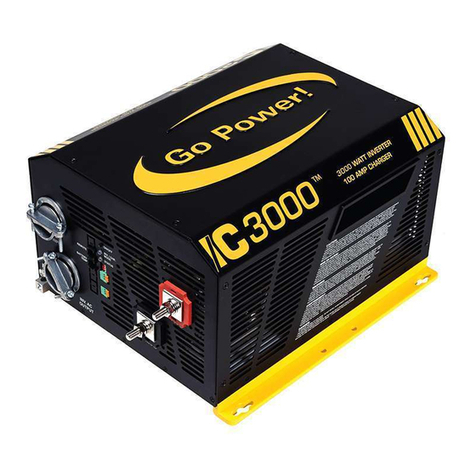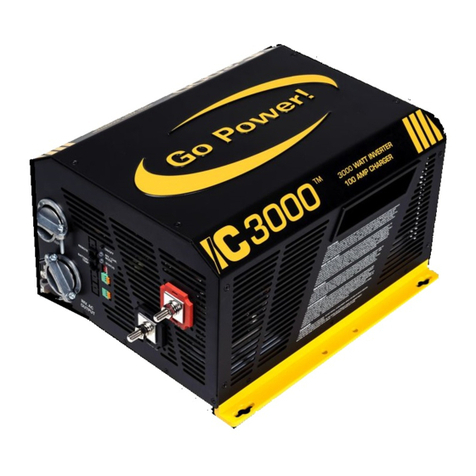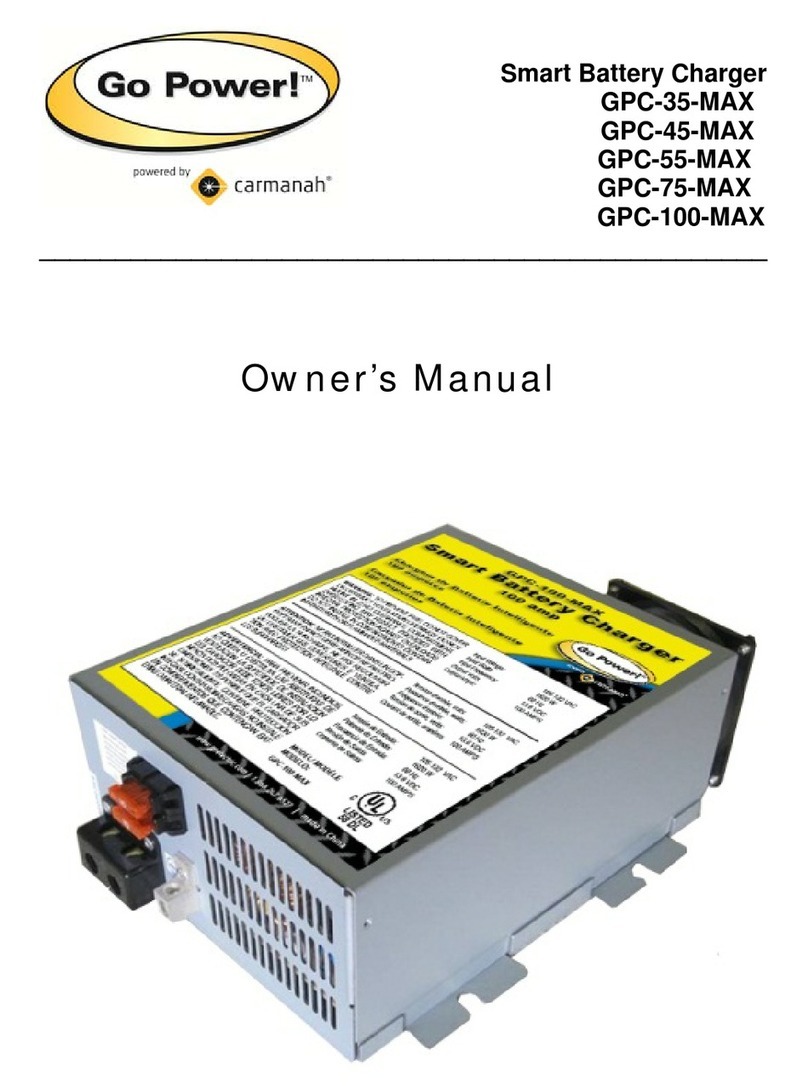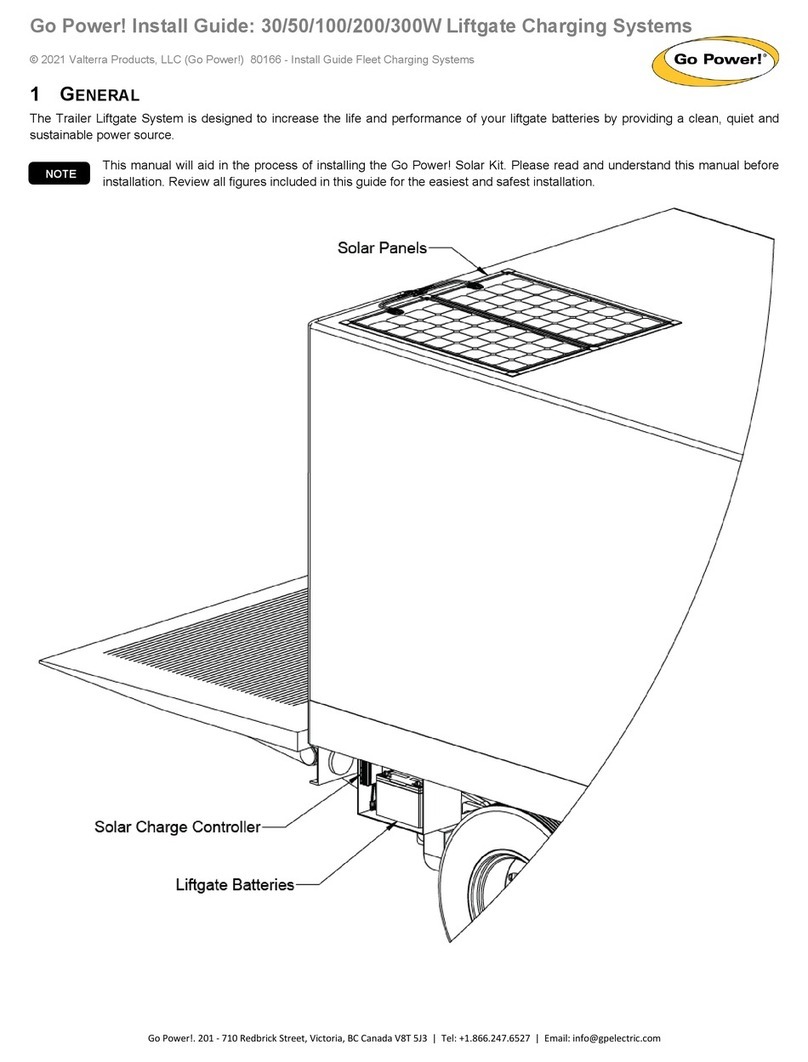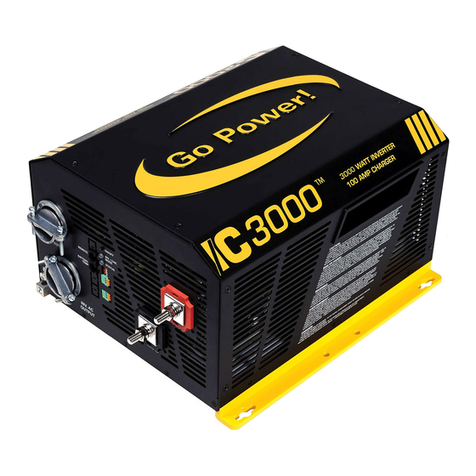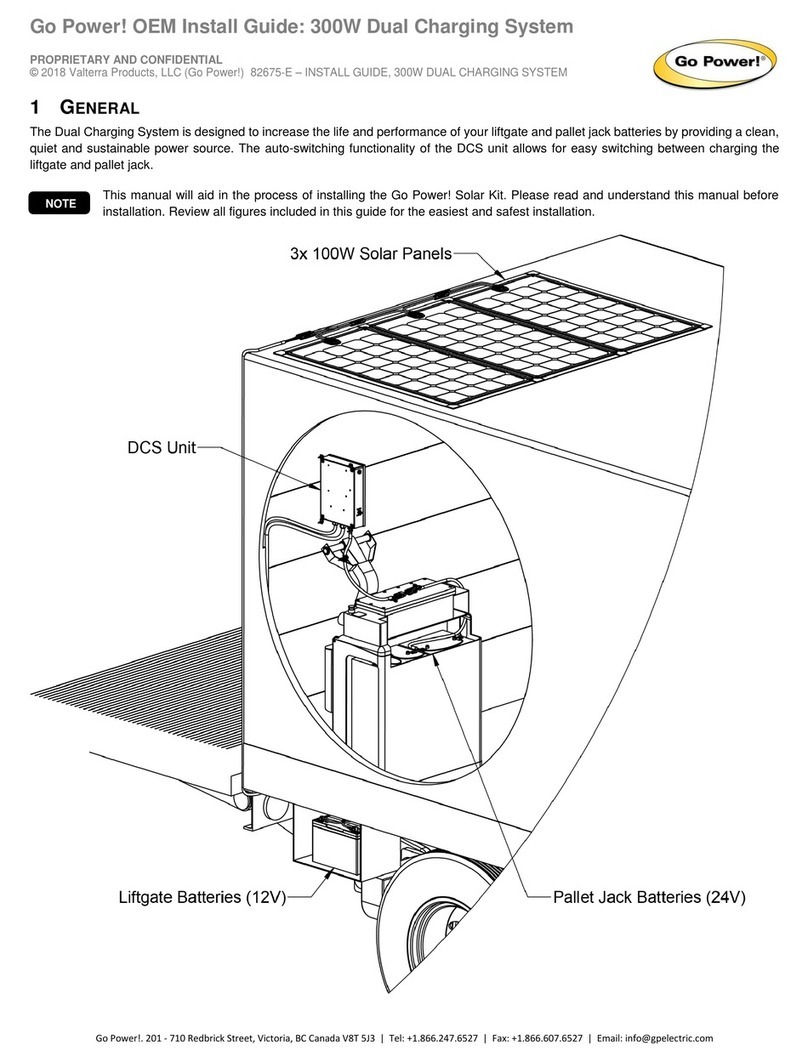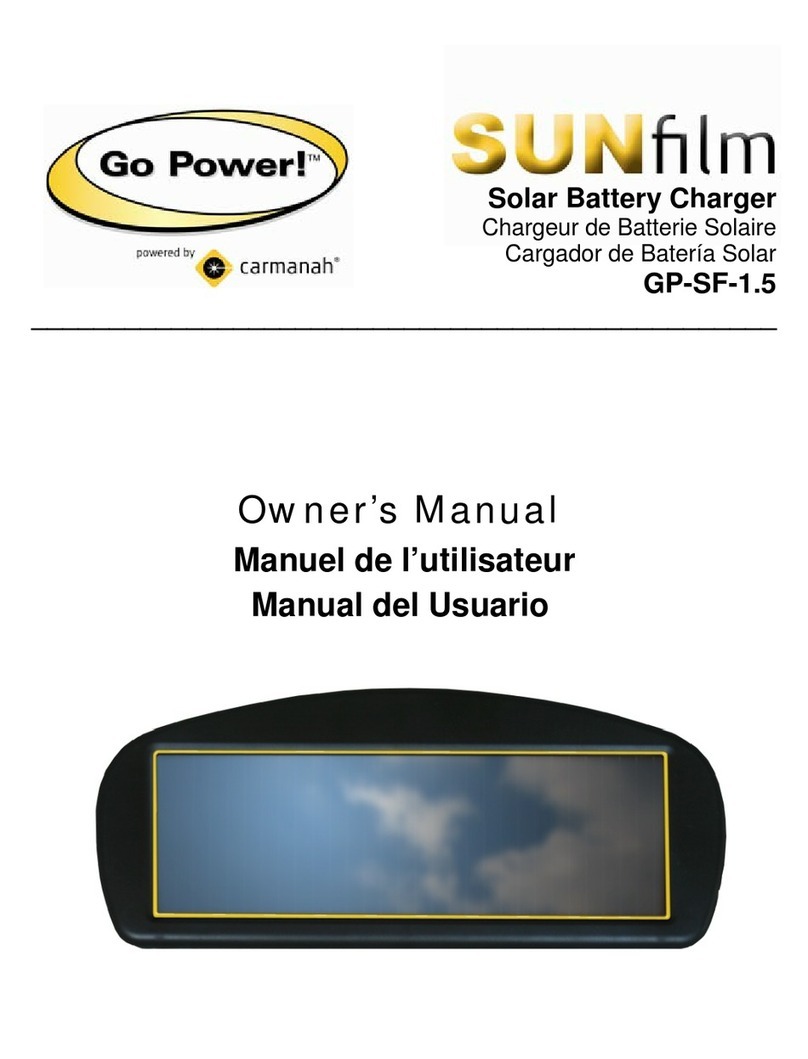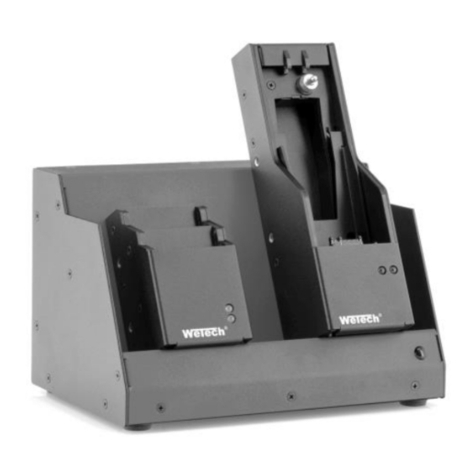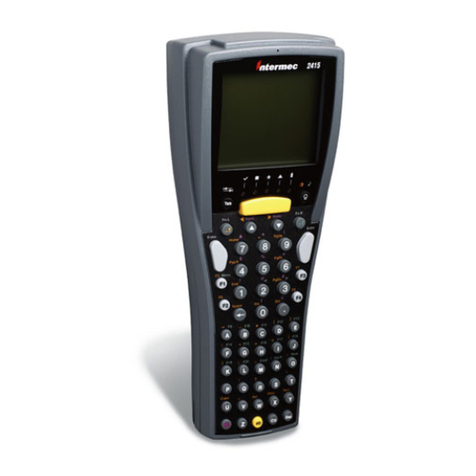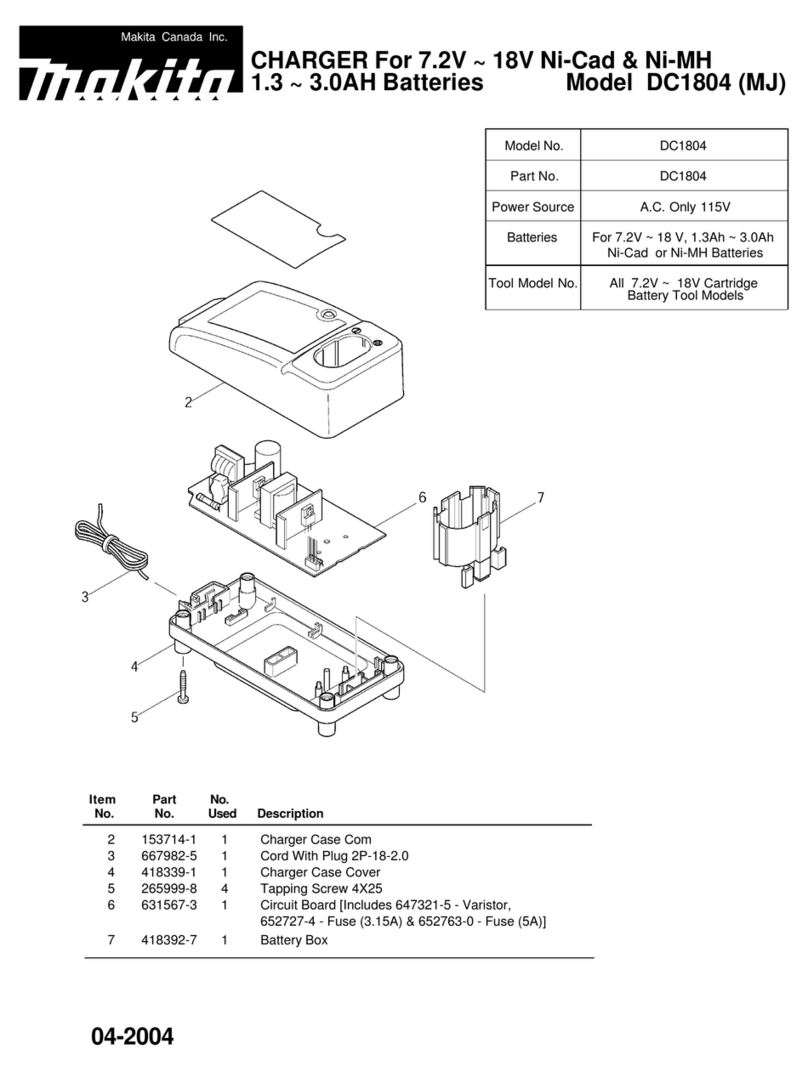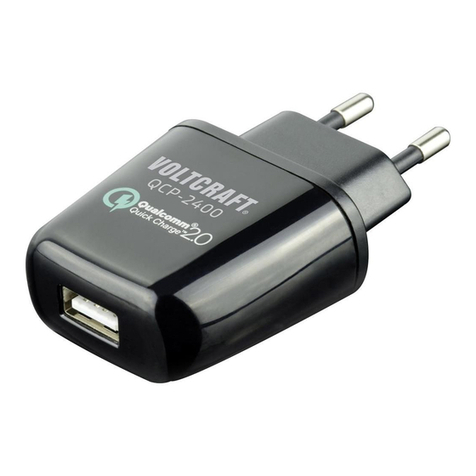Go Power GP-PWM-25 User manual

Go Power! Manual
GP-PWM-25 Regulator

Owner’s Manual | GP-PWM-25 Regulator
2
© 2009 Carmanah Technologies Corporation
Last revised July 2009

CONTENTS
1.0 Installation Overview.................................................................................4
1.1 Introduction...............................................................................................4
1.2 Specifications............................................................................................4
2.0 Warnings.....................................................................................................5
3.0 Tools and Materials Needed......................................................................5
4.0 Choosing a Location .................................................................................6
5.0 Installation Instructions.............................................................................6
6.0 Operating Instructions...............................................................................7
7.0 Before You Read Troubleshooting.........................................................10
8.0 Troubleshooting Problems .....................................................................11
8.1 Problems with the Display.......................................................................11
8.2 Problems with Voltage ............................................................................11
8.3 Problems with Current ............................................................................12
9.0 Limited Warranty......................................................................................13
9.1 General Warranty Issues .....................................................................13
9.2 Repair and Return Information.............................................................14
10.0 Glossary…………………………………………………………………………15
11.0 Installation Template ...............................................................................16
12.0 Wiring Diagram ........................................................................................17

Owner’s Manual | GP-PWM-25 Regulator
4
© 2009 Carmanah Technologies Corporation
Last revised July 2009
1.0 Installation Overview
1.1 Introduction
A Charge Regulator is an essential component of your photovoltaic (PV) system. The Regulator
maintains the life of the battery by protecting it from overcharging. When your battery has
reached a 100% state of charge, the Regulator prevents overcharging by limiting the current
flowing into the batteries from your solar array.
The GP-PWM-25 is an automatic selecting 12 or 24 volt flush mounted photovoltaic (PV) charge
controller rated for a continuous solar current input of 25 amps. The GP-PWM-25 uses pulse
width modulation technology and a unique four stage charging system and optional equalize
setting to charge and protect your battery bank. The GP-PWM-25 features an LCD digital display
that shows solar array charge current, system battery voltage and battery capacity. The GP-
PWM-25 display has a power saving feature that shuts the display off after 30 minutes of no user
activity
1.2 Specifications
Description Value
Nominal System Voltage 12/24V, automatic selection
Max. Solar Array Current 25 Amps
Battery Voltage Range 6V – 31V
Max. Solar Voltage 56V
Operating Consumption
Display Consumption 6mA
10mA
Absorption Voltage 14.1/14.4V 28.2/28.8V
(25°C / 77°F), 0.5-2h / Day
Float Voltage 13.7/27.4V (25°C / 77°F)
Equalization Voltage 14.8/29.6V (25°C / 77°F),
2h / 28 Day or V < 12.1/24.2
Temperature Compensation -4mV/cell*K
Operating Temperature
Display Operating Temperature -40 to 85°C / -40 to 185°F
-20 to 55°C / -4 to 131°F
Humidity 99% N.C.
Protection Battery Reverse Polarity,
Solar Array Reverse Polarity
(12V input only), Over
Temperature, PV Short Circuit,
Over Current
The total rated Maximum Power Current (Imp) of the PV
input should not exceed 25 Amps.
The GP-PWM-25 will limit PV current above 25 Amps.
Although the GP-PWM-25 will accept PV current greater than 25
Amps for a short duration, damage may occur if the GP-PWM-
25 operates continuously with greater than 25 Amps of PV input.
Dimensions (H x W x D):
107 x 190 x 35 mm
4.25 x 7.5 x 1.38 in
Weight: 278 grams
10 oz
Maximum Wire Gauge: #6 AWG
Warranty: 5 years
•PWM Charging.
•3 Battery Charging profiles.
•4 Stage Charging.
•Monthly Equalize option.
•Displays Charging Current,
Battery Voltage and Battery
State of Charge.
•Reverse Polarity protected.
•Temperature Compensated.
•RoHS Compliant,
environmentally safe
•Accepts over 400 Watts of
solar at 12 volts.

Owner’s Manual | GP-PWM-25 Regulator
5
© 2009 Carmanah Technologies Corporation
Last revised: July 2009
2.0 Warnings
Disconnect all power
sources
Electricity can be very dangerous.
Installation should be performed only
by a licensed electrician or qualified
personnel.
Battery and wiring safety
Observe all safety precautions of the
battery manufacturer when handling
or working around batteries. When
charging, batteries produce
hydrogen gas, which is highly
explosive.
Wiring connections
Ensure all connections are tight and
secure. Loose connections may
generate sparks and heat. Be sure
to check connections one week after
installation to ensure they are still
tight.
Work safely
Wear protective eyewear and
appropriate clothing during
installation. Use extreme caution
when working with electricity and
when handling and working around
batteries.
Observe correct polarity
Reverse polarity of the battery
terminals will cause the regulator to
give a warning tone. Reverse
connection of the array will not
cause an alarm but the controller will
not function. Failure to correct this
fault could damage the regulator.
Do not exceed the GP-PWM-
25 Amp current and max
voltage ratings
The current rating of the solar
system is the sum of the Maximum
Power Current (Imp) of the solar PV
strings in parallel. The resulting
system Imp current is not to exceed
25 A. The voltage of the array is the
rated open circuit voltage (Voc) of
the PV array and is not to exceed 56
V. If your solar system exceeds
these ratings, contact your dealer for
a suitable regulator alternative.
3.0 Tools and Materials Needed
•Drill with 3/32” and 3/8 bits
•UV Wire (Solar Array) to GP-PWM-25)*
•Keyhole or Jigsaw •Battery Wire (GP-PWM-25 to Battery)*
•Phillips Screwdriver •Wire Cutters
•Pencil or Marking Implement •Wire Strippers
•Torque wrench (optional) •Electrical Tape
If the GP-PWM-25 Regulator was purchased with a Go Power! RV Solar Power
Kit then UV resistant wire is included. For instructions regarding the Go Power!
RV Solar Power Kit installation, please refer to the Installation Guide provided
with the Kit.

Owner’s Manual | GP-PWM-25 Regulator
6
© 2009 Carmanah Technologies Corporation
Last revised July 2009
4.0 Choosing a Location
The GP-PWM-25 is designed to be mounted flush against a wall, out of the way but easily visible.
The GP-PWM-25 should be:
•mounted as close to the battery as possible.
•mounted on a vertical surface to optimize cooling of the unit.
•indoors, protected from the weather.
In a RV, the most common regulator location is above the refrigerator. The wire from the solar
array most commonly enters the RV through the fridge vent on the roof. PV connections should
connect directly to the regulator. Positive and negative battery connections must connect directly
from the regulator to the batteries. Use of a positive or negative distribution bus is allowed
between the regulator and battery as long as it is properly sized, electrically safe and an
adequate wire size is maintained.
5.0 Installation Instructions
1. Prepare for mounting. Use the template provided at the end of the manual to mark the
four mounting holes and the “cutting line for flush mounting.”
2. Complete the installation of the solar modules. If this GP-PWM-25 was purchased as
part of a Go Power! Solar Power Kit, follow the Installation Guide provided. Otherwise
follow manufacturer’s instructions for solar module mounting and wiring.
3. Select wire type and gauge. If this GP-PWM-25 was purchased as part of a Go Power!
Solar Power Kit, appropriate wire type, gauge, and length is provided. Please continue to
Section 6, “Operating Instructions.” If the GP-PWM-25 was purchased separately, follow
the instructions included here.
Wire type is recommended to be a stranded copper UV resistant wire. Wire fatigue and the
likelihood of a loose connection are greatly reduced in stranded wire compared to solid wire. Wire
gauge should be able to sustain rated current as well as minimizing voltage drop.
Suggested Minimum Wire Gauge
(Cable length 25 ft max. from solar array to battery bank)
50 Watt #14 Wire Gauge
80 Watt #12 Wire Gauge
95 Watt #10 Wire Gauge
115 Watt #10 Wire Gauge
160 Watt #10 Wire Gauge
240 Watt #10 Wire Gauge
Terminal Screw Torque 16 inch pounds (1.8N.m)
IMPORTANT: Identify the polarity (positive and negative) on the cable used for the battery and
solar module. Use colored wires or mark the wire ends with tags. Although the GP-PWM-25 is
protected, a reverse polarity contact may damage the unit.

Owner’s Manual | GP-PWM-25 Regulator
7
© 2009 Carmanah Technologies Corporation
Last revised: July 2009
4. Wiring the GP-PWM-25. Wire the GP-PWM-25 according to the wiring schematic in
Section 11. Run wires from the solar array and the batteries to the location of the GP-
PWM-25. Keep the solar array covered with an opaque material until all wiring is
completed.
Torque all terminal screws to 16 inch pounds (1.8N.m)
Connect the battery wiring to the regulator first and then connect the battery wiring to the
battery.
IMPORTANT: Always use appropriate circuit protection on any conductor attached to a
battery.
With battery power attached, the regulator should power up and display information.
Connect the solar wiring to the regulator and remove the opaque material from the solar
array. The negative solar array and battery wiring must be connected directly to the
regulator for proper operation. Do not connect the negative solar array or negative battery
regulator wiring to the chassis of the vehicle.
5. Mounting the GP-PWM-25. Mount the GP-PWM-25 to the wall using the included four
mounting screws.
Congratulations, your GP-PWM-25 should now be operational. If the battery power is low and the
solar array is producing power, your battery should begin to charge.
6. Re-torque:
After 30 days of operation re torque all terminal screws to ensure the wires are properly
secured to the controller.
6.0 Operating Instructions
Power Up
When the GP-PWM-25 is connected to the battery, the
GP-PWM-25 will go into Power Up mode. The controller
will select the battery voltage automatically. If the battery
voltage is above 20 Volts the controller assumes a 24
Volt battery system.
Icons Displayed: Three horizontal dashes
Sleep Mode
If the GP-PWM-25 is in Sleep Mode, the display will be
blank. Press the A Button to wake it up.
NOTE: If the battery voltage is below 6 Volts the GP-
PWM-25 will not function.
Sleep Mode: The GP-PWM-25 will go into “sleep mode” after 30 minutes of no user activity
(pushing the buttons). In sleep mode the GP-PWM-25 turns it’s display off to conserve power. To
bring the regulator out of sleep mode, simply press the A Button and the display will reappear.

Owner’s Manual | GP-PWM-25 Regulator
8
© 2009 Carmanah Technologies Corporation
Last revised July 2009
Setting the Battery Type / Charging Profile
Set the Battery Type / Charging Profile by holding down
the B Button for 10 seconds. When the display begins
blinking you may set the Battery Type by toggling
through the Charging Profile numbers 1, 2 or 3 by
pressing the B Button.
Confirm the Battery Type / Charging Profile selection by
pressing the A Button.
Depending on the battery voltage when the GP-PWM-25
Power Up occurs, the GP-PWM-25 may do a Boost
Charge or quickly go into Float Charge. The Charging
Profile selected will commence the following day after a
Power Up.
Auto Equalize: The GP-WWM-25 has an automatic equalize feature that will charge and
recondition your batteries once a month at a higher voltage to ensure that any excess sulfation is
removed. This feature is recommended for Flooded batteries only. Check with your battery
manufacturer.
NOTE: This feature is only available for Charging Profile 1.
Battery Type FLOODED AGM GEL
Charging Profile # 1 2 3
Float Charge @ 25°C: 13.7 / 27.4V
Bulk/Absorption
Charge @ 25°C:
Applied for 30 min each
morning
14.4 / 28.8V 14.1 / 28.2V
Boost Charge
Applied for 2 hours if
the battery voltage
drops bellow 12.3 volts.
14.4 / 28.8V 14.1 / 28.2V
Equalization Charge
Applied for 2 hours
every 28 days and if
the battery voltage
drops bellow 12.1 volts.
14.8 / 29.6V N/A N/A
The Boost Charge will occur in addition to the Bulk Charge. The
Equalization Charge will occur in addition to the Boost Charge.
If a charging cycle is unable to complete in a single day, it will
continue the following day.
The terms FLOODED, AGM and GEL are generic battery
designations. Choose the charging profile that works best with your
battery manufacturer’s recommendations.

Owner’s Manual | GP-PWM-25 Regulator
9
© 2009 Carmanah Technologies Corporation
Last revised: July 2009
Viewing the Regulator display information
To toggle between State of Charge (SOC), Battery
Voltage and PV Charging Current, press the B
Button.
The battery state of charge is shown as a percentage.
Icons Displayed: Battery, Percent Symbol
Push the B Button to show the battery voltage.
Icons Displayed: Battery, Volt Symbol (V)
Push the B Button to show the PV charging current.
The GP-PWM-25 will begin to limit the current as the
battery reaches a full charge.
Icons Displayed: Sun, Battery, Current Symbol (A)
Non volatile memory: Any settings made on the GP-PWM-25 will be saved even when the
power has been disconnected from the regulator.
Errors
Over Voltage
If the GP-PWM-25 experiences a battery over voltage
(15.5 / 31V), the controller will stop operating and the
display will begin to flash. The controller will resume
operating when the error is cleared.
Icons Displayed: Battery, Volt Symbol, Lightning Bolt
Low Voltage
If the GP-PWM-25 experiences the battery state of
charge reaching zero, a lightning bolt symbol will begin
to flash in the lower right corner of the display. The
regulator will continue operating. The regulator will only
stop operating if the voltage drops below 6 volts.
Icons Displayed: Battery, Percent Symbol, Lightning
Bolt

Owner’s Manual | GP-PWM-25 Regulator
10
© 2009 Carmanah Technologies Corporation
Last revised July 2009
7.0 Before You Read Troubleshooting
Before a problem is suspected with the system, read this section. There are numerous events
that may appear as problems but are in fact perfectly normal.
It seems like my flooded batteries are losing water over time.
Flooded batteries may need to have distilled water added periodically to replace fluid loss during
charging. Excessive water loss during a short period of time indicates the possibility of
overcharging or aging batteries.
When charging, my flooded batteries are emitting gas.
During charging, hydrogen gas is generated within the battery. The gas bubbles stir the battery
acid allowing it to receive a more full state of charge. Ensure they are in a well ventilated space.
My voltmeter shows a different reading than the GP-PWM-25 display
The meter value on the GP-PWM-25 display is an approximate reading intended for indication
purposes only. There is an approximate 0.1 volt inherent error present that may be accentuated
when compared with readings from another voltmeter.
There may be a slight difference between the battery voltage displayed on the GP-PWM-25
display and the battery voltage measured at the battery terminals. When troubleshooting using a
voltmeter, check both the battery voltage at the GP-PWM-25 battery terminals and battery voltage
at the battery terminals. If a difference of more than 0.5 Volts is noted, this indicates a large
voltage drop possibly caused by loose connections, long wire runs, small wire gauge, faulty
wiring, a faulty voltmeter or all the above. Consult the Suggested Minimum Wire Gauge chart in
Section 5 for wiring suggestions and check all connections.

Owner’s Manual | GP-PWM-25 Regulator
11
© 2009 Carmanah Technologies Corporation
Last revised: July 2009
8.0 Troubleshooting Problems
How to read this section
Troubleshooting Problems is split into three sub-sections, grouped by symptoms involving key
components. Components considered irrelevant in a diagnosis are denoted ‘Not Applicable’
(N/A). A multimeter or voltmeter may be required for some procedures listed.
It is imperative all electrical precautions stated in the Warning Section and outlined in the
Installation Section are followed. Even if it appears the system is not functioning, it should be
treated as a fully functioning system generating live power.
8.1 Problems with the Display
Display Reading: Blank
Time of Day: Daytime/Nighttime
Possible Cause:
(1) Unit is in Sleep Mode as per normal operation after no user activity for 30 minutes.
(2) Battery or fuse connection and/or solar array connection (Daytime only).
(3) Battery or fuse connection (Nighttime only).
How to tell:
(1) Wake up the unit by pushing the A Button.
(2) & (3) Check the voltage at the regulator battery terminals with a voltmeter and compare with a voltage reading at the
battery terminals.
If there is no voltage reading at the regulator battery terminals, the problem is in the wiring between the battery and the
regulator. If the battery voltage is lower than 6 volts the regulator will not function.
For the solar array, repeat steps 2 and 3 substituting all battery terminals with solar array terminals.
Remedy:
(2) & (3) Check all connections from the regulator to the battery including checking for correct wire polarity. Check that all
connections are clean, tight, and secure. Ensure the battery voltage is above 6 volts.
8.2 Problems with Voltage
Voltage Reading: Inaccurate
Time of Day: Daytime/Nighttime
Possible Cause:
(1) Excessive voltage drop from batteries to regulator due to loose connections, small wire gauge or both.
How to tell:
(1) Check the voltage at the regulator battery terminals with a voltmeter and compare with the voltage reading at the
battery terminals. If there is a voltage discrepancy of more than 0.5 V, there is an excessive voltage drop.
Remedy:
(1) Check all connections from the regulator to the battery including checking for correct wire polarity. Check that all
connections are clean, tight, and secure. Shorten the distance from the regulator to battery or obtain larger gauge
wire. It is also possible to double up the existing gauge wire (i.e. two wire runs) to simulate a larger gauge wire.

Owner’s Manual | GP-PWM-25 Regulator
12
© 2009 Carmanah Technologies Corporation
Last revised July 2009
8.3 Problems with Current
Current Reading: 0 A
Time of Day: Daytime, clear sunny skies
Possible Cause:
(1) Current is being limited below 1 Amp as per normal operation.
(2) Poor connection between solar array and regulator
How to tell:
(1) The State of Charge (SOC) screen is close to 100% and the Sun and Battery icon are present with an arrow between.
(2) With the solar array in sunlight, check the voltage at the regulator solar array terminals with a voltmeter. If there is no
reading at the regulator solar array terminals, the problem is somewhere in the wiring from the solar array to the
regulator.
Remedy:
(2) Check all connections from the regulator to the array including checking for correct wire polarity. Check that all
connections are clean, tight, and secure.
Continue with the solutions below for additional help on low current readings.
Current Reading: Less than expected
Time of Day: Daytime, clear sunny skies
Possible Cause:
(1) Current is being limited below 1 Amp as per normal operation
(2) Incorrect series/parallel configuration and/or wiring connections and/or wire gauge.
(3) Dirty or shaded module or lack of sun.
(4) Blown diode in solar module when two or more modules are connected in parallel.
How to tell:
(1) Battery State of Charge screen is close to 100% and the Sun and Battery icon are present with an arrow in between.
(2) Check that the modules and batteries are configured correctly. Check all wiring connections.
(3) Modules look dirty, overhead object is shading modules or it is an overcast day in which a shadow cannot be cast.
Note: Avoid any shading no matter how small. An object as small as a broomstick held across the solar module may
cause the power output to be cut to almost nil. Overcast days may also cut the power output of the module to almost
nil.
(4) Disconnect one or both array wires from the regulator. Take a voltage reading between the positive and negative
array wire. A single 12 volt module should have an open circuit voltage between 17 and 22 volts (double these
numbers for a 24 volt system). If you have more than one solar module, you will need to conduct this test between
the positive and negative terminals of each module junction box with either the positive or negative wires
disconnected from the terminal.
Remedy:
(2) Reconnect in correct configuration. Tighten all connections. Check wire gauge and length of wire run. Refer to
Suggested Minimum Wire Gauge in Section 5.
(3) Clean modules, clear obstruction or wait for conditions to clear.
(4) If the open circuit voltage of a non-connected 12 volt module is lower than the manufacturer’s specifications, the
module may be faulty. Check for blown diodes in the solar module junction box, which may be shorting the power
output of module.

Owner’s Manual | GP-PWM-25 Regulator
13
© 2009 Carmanah Technologies Corporation
Last revised: July 2009
9.0 Limited Warranty
1. Carmanah warrants the GP-PWM-25 for a period of five (5) years from the date of
shipment from its factory. This warranty is valid against defects in materials and
workmanship for the five (5) year warranty period. It is not valid against defects resulting
from, but not limited to:
•Misuse and/or abuse, neglect or accident.
•Exceeding the unit’s design limits
•Improper installation, including, but not limited to, improper environmental
protection and improper hook-up
•Acts of God, including lightning, floods, earthquakes, fire, and high winds
•Damage in handling, including damage encountered during shipment
2. This warranty shall be considered void if the warranted product is in any way opened or
altered. The warranty will be void if any eyelet, rivets, or other fasteners used to seal the
unit are removed or altered, or if the unit’s serial number is in any way removed, altered,
replaced, defaced, or rendered illegible.
9.1 General Warranty Issues
Please refer to the manufacturers’ warranty sheet(s).
1. Carmanah cannot assume responsibility for any damages to any system components
used in conjunction with Carmanah products nor for claims for personal injury or property
damage resulting from the use of Carmanah products or the improper operation thereof
or consequential damages arising from the products or use of the products.
2. Carmanah cannot guarantee compatibility of its products with other components used in
conjunction with Carmanah products, including, but not limited to, solar modules,
batteries, and system interconnects, and such loads as inverters, transmitters, and other
loads which produce “noise” or electromagnetic interference, in excess of the levels to
which Carmanah products are compatible.
3. Warranty repair and/or evaluation will be provided only at the Victoria, British Columbia
facility of Carmanah. Units for such repair and/or evaluation must be returned freight
prepaid to Carmanah with a written description of any apparent defects. Carmanah will
not be required at any time to visit the installation site wherein Carmanah products are
subject to warranty repair and/or evaluation.
4. Only Carmanah is authorized to repair any of its products, and they reserve the right to
repair or replace any unit returned for warranty repair. The party returning a unit for repair
is responsible for proper packaging and for shipping and insurance charges, as well as
any other charges encountered, in shipping to and from Carmanah.
5. The purchaser’s exclusive remedy for any and all losses or damages resulting from the
date of sale of this product including, but not limited to, any allegations of breach of
warranty, breach of contract, negligence or strict liability, shall be limited, at Carmanah
option, to either the return of the purchase price or the replacement of the particular
product for which claim is made and proved. In no event shall Carmanah be liable to
purchaser or purchaser’s customers or to anyone else for any punitive, special,
consequential, incidental or indirect losses or damages resulting from the sale of the
product, whether based upon loss of goodwill, lost profits, work stoppages, impairments
of other goods, breach of contract, or otherwise.

Owner’s Manual | GP-PWM-25 Regulator
14
© 2009 Carmanah Technologies Corporation
Last revised July 2009
6. This warranty supersedes all other warranties and may only be modified by statement in
writing, signed by Carmanah.
7. Warranty terms effective as of January, 2009.
9.2 Repair and Return Information
To return items:
1. Call your Carmanah dealer or Carmanah’s technical SUPPORT (1-800-667-6527) to try
and troubleshoot the problem.
2. Obtain an RMA # by calling your Carmanah sales representative or the RMA department
customerservice@carmanah.com.
3. Ensure the RMA # is clearly visible on the outside of the package, or THE PACKAGE
WILL BE REFUSED.
4. For Returns from Canada, ship to Carmanah Victoria PREPAID at the following address:
Carmanah Technologies
Building 4, 203 Harbour Road
Victoria, British Columbia
Canada V9A 3S2
5. For Returns from the US, ship to Carmanah PREPAID at the following address:
Gwynn Swartos or Gary Winters
FedEx Trade Networks
1750 Grant Avenue
Blaine, WA 98230
(360) 332-3080
6. Ensure the product is not shipped collect, unless approved by management prior to
Carmanah receiving said product, or THE PACKAGE WILL BE REFUSED.
7. Test items or items that are not under warranty, or units that are not defective, will be
charged a minimum bench charge of ($50.00 US) plus taxes and shipping.
8. A 15% restocking charge will be applied on goods returned and accepted as “new” stock.

Owner’s Manual | GP-PWM-25 Regulator
15
© 2009 Carmanah Technologies Corporation
Last revised: July 2009
10.0 Glossary
Ampere: A unit of electrical current. Designates the number of electrons flowing per second through a conductive
material.
Array: One or more photovoltaic (PV) modules electrically connected to produce a single electrical output.
Battery: Two or more electrochemical cells connected to provide energy storage.
May be used to designate one cell. PV system batteries may be “sealed” or “wet acid”.
Charge Controller: The PV system component that controls the battery’s state of charge. It may also provide other
system control functions. Also referred to as a regulator.
Charge Rate: The current applied to a battery to restore its energy capacity. The battery manufacturer will usually have a
recommended charge rate for their product. The rate is typically 10 –20 percent of the amp hour capacity at the 20-hour
rate.
Current: DC or Direct Current is the type of electron flow provided by a battery or solar cell, which flows in one direction.
The unit for current is ampere or amp for short and designated by the letter A.
Deep Cycle Battery: Batteries that are designed to discharge as much as 80% of their capacity as opposed to engine-
starting or “shallow cycle” batteries which are designed for heavy cranking but will not stand up to repeated deep
discharges.
Equalization: The process that equalizes the specific gravity of all the cells in a battery by means of a controlled
overcharge that breaks down sulfation on the battery plates. Most inverter/chargers and some charge controllers are
equipped with this feature.
Maximum Power: Also referred to as peak power. The point of a solar array, panel or module output where the product
of “Imp” and “Vmp” (“Pmax”, measured in watts) is maximized. The points used to calculate Pmax are Imp (current @ max
power) and Vmp (voltage @ max power).
Solar Module: A number of solar cells electrically connected, and protected from the environment usually by an
aluminum frame covered with a pane of glass. A module is self-contained and not sub dividable, therefore providing a
single electrical output.
Open-Circuit Voltage (Voc): Refers to a photovoltaic device’s voltage potential when it is disconnected from the rest of
the PV system.
Parallel Connection: Electrical connection where the positive terminals of a number of devices are connected together,
as are their negative terminals. The output voltage is usually limited to the device with the lowest voltage, and the total
current is the sum of the current of all the devices.
Photovoltaic (PV): Capable of producing a voltage when exposed to radiant energy, especially light.
Sealed Batteries: Electrolyte will not spill out and gassing is kept to a minimum. A sealed battery is maintenance free
and may be installed in several orientations. GEL and AGM are two common types of sealed batteries.
Series Connection: Electrical connection where the positive terminal of one device is attached to the negative terminal
of the next in a series string; in this connection, the string voltage is the sum of the device voltages and the string current
is limited to the current of the least productive device in the string.
Short-Circuit Current (Isc): Refers to a photovoltaic device’s current output when the positive terminal is directly
connected to the negative terminal.
State of Charge (SOC): The percentage of energy in a battery referenced to its nominal full capacity.
Sulfation: The formation of lead sulfate crystals on the plates of a lead-acid battery. Normally used to refer to large
sulfate crystals, rather than small crystals formed in normal battery operation. The plates of a battery will sulfate if left in a
partially charged state, causing reduced battery capacity and shortening the life of the battery. If caught in time,
equalization will remove the buildup of sulfation.
Voltage: The electrical potential between two points. Voltage is analogous to water pressure in that it pushes the
electrons or current through a conductor. The unit for voltage is volt and designated by the letter V.
Wet Acid or Flooded Batteries: The most common type of PV battery. Battery caps may be removed to expose the
electrolyte liquid inside the battery. Need proper ventilation due to gassing and may need to be topped up with distilled
water at regular intervals.

Owner’s Manual | GP-PWM-25 Regulator
16
© 2009 Carmanah Technologies Corporation
Last revised July 2009
11.0 Installation Template

Owner’s Manual | GP-PWM-25 Regulator
17
© 2009 Carmanah Technologies Corporation
Last revised: July 2009
12.0 Wiring Diagram
SUGGESTED FUSE SIZE
#14 WIRE = 15 AMP FUSE
#12 WIRE = 20 AMP FUSE
#10 WIRE = 30 AMP FUSE
NOTE:
THE FUSE IS INTENDED TO PROTECT
THE WIRE.
THE GP-PWM-25 IS BASED ON A 25 AMP MAX FOR THE
TOTAL IMP OF THE SYSTEM.
E.G. THREE MODULES IN PARALLEL WITH AN IMP OF 7
AMPS EACH EQUALS A TOTAL IMP OF 21 AMPS.
MOST SOLAR MODULES LIST THE IMP ON THEIR
SPECIFICATIONS LABEL.
SOLAR ARRAY
BATTERY BANK
FUSE

© 2009 Carmanah Technologies Corporation
carmanah.com
Toll Free (US and Canada): 1-800-667-6527
Worldwide: 1-250-652-5233
Toll Free Fax (US and Canada): 1-866-607-6527
Number: 57175_MAN_GP-PWM-25 Regulator_RevB-8.5x11
57175
Table of contents
Other Go Power Batteries Charger manuals
Popular Batteries Charger manuals by other brands
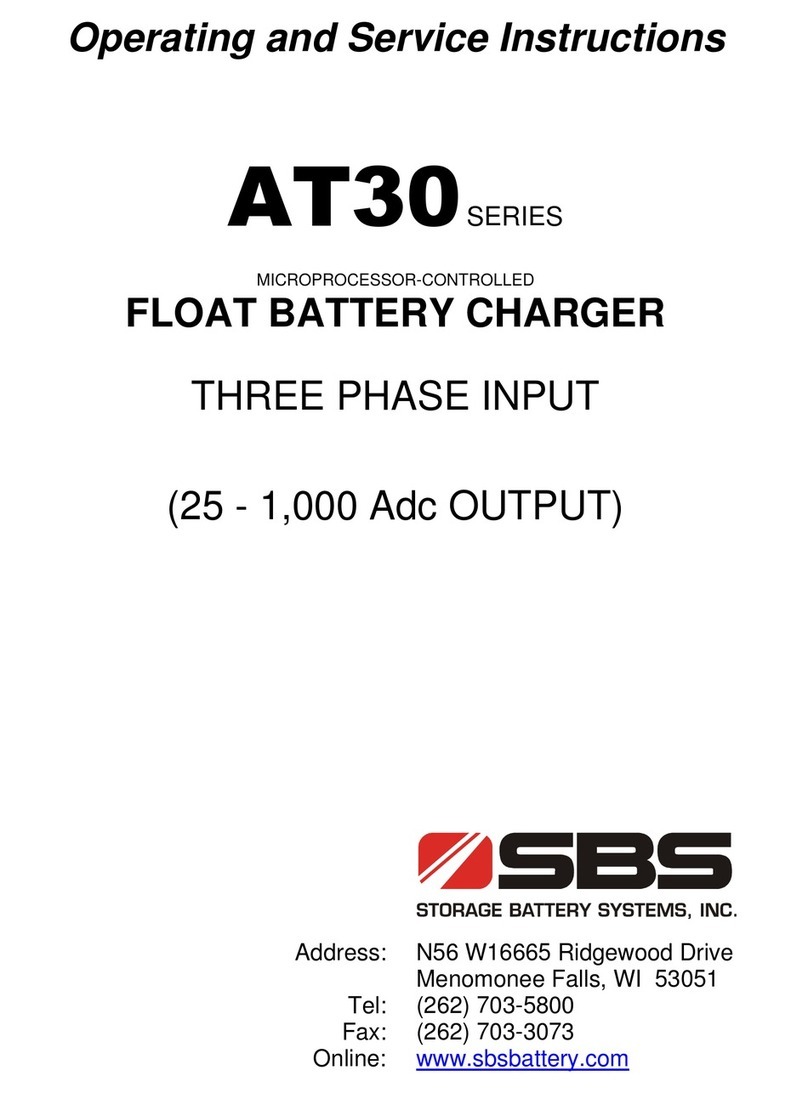
SBS
SBS AT30 SERIES Operating and service instructions
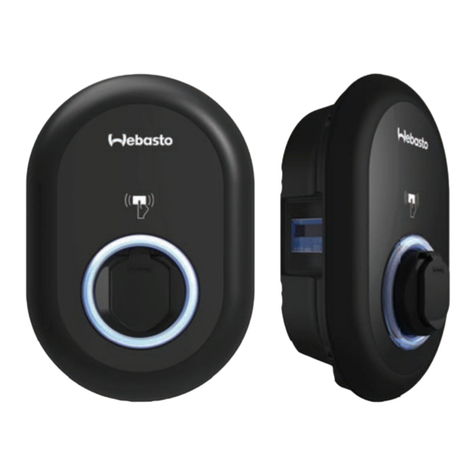
Webasto
Webasto Unite Operating and installation instructions

Black & Decker
Black & Decker BDV090AU instruction manual

Motorola solutions
Motorola solutions IMPRES 2 NNTN8895 user guide
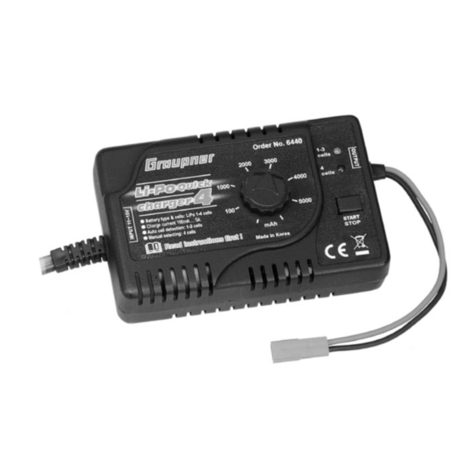
GRAUPNER
GRAUPNER LIPO-QUICK-CHARGER 4 operating manual
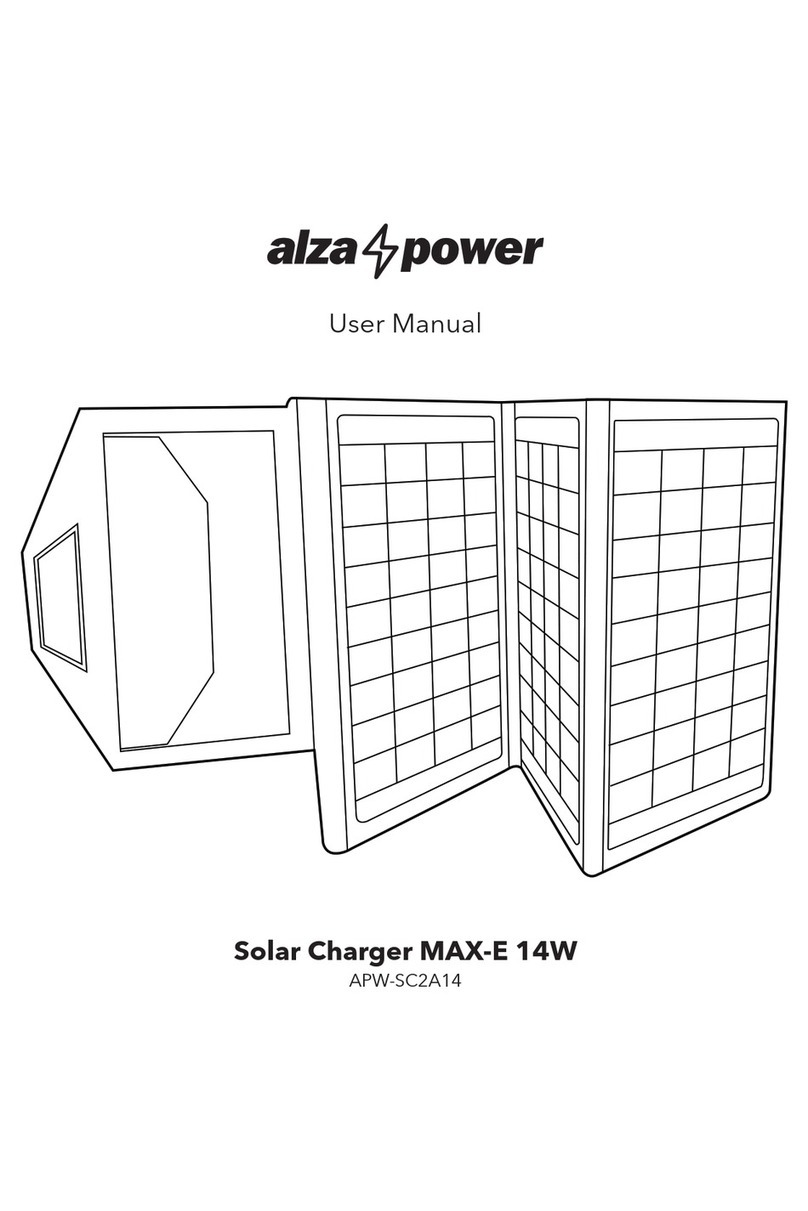
AlzaPower
AlzaPower MAX-E 14W user manual
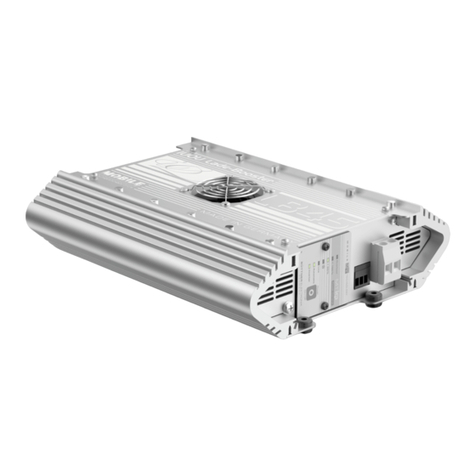
Dometic
Dometic BUTTNER MT LB30 Installation and operating manual
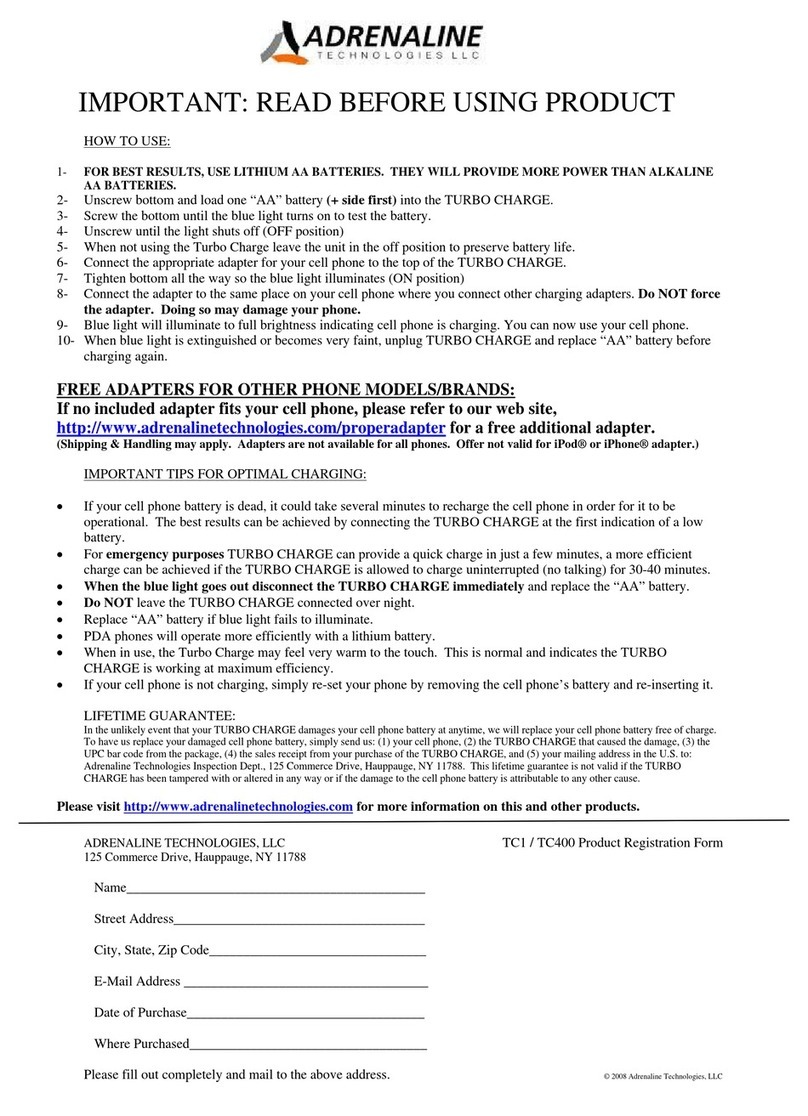
Adrenaline Technologies
Adrenaline Technologies TURBO CHARGE TC1 user guide
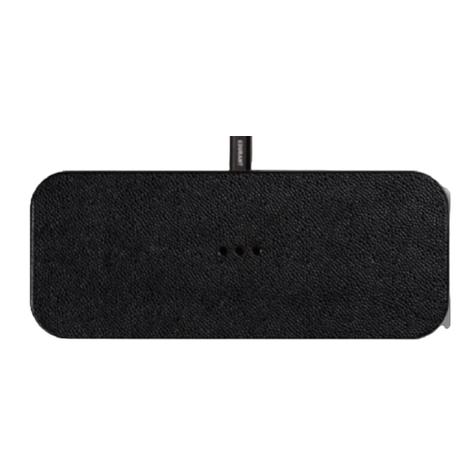
COURANT
COURANT Catch2 ESSENTIALS quick start guide

Schumacher Electric
Schumacher Electric DSR134 owner's manual
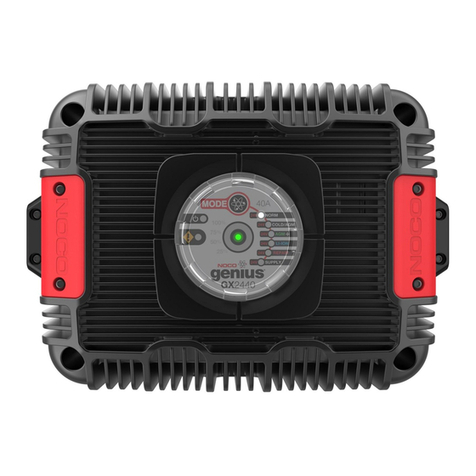
Genius
Genius GX2440 user guide

Bahco
Bahco BBH12-1200 owner's manual
